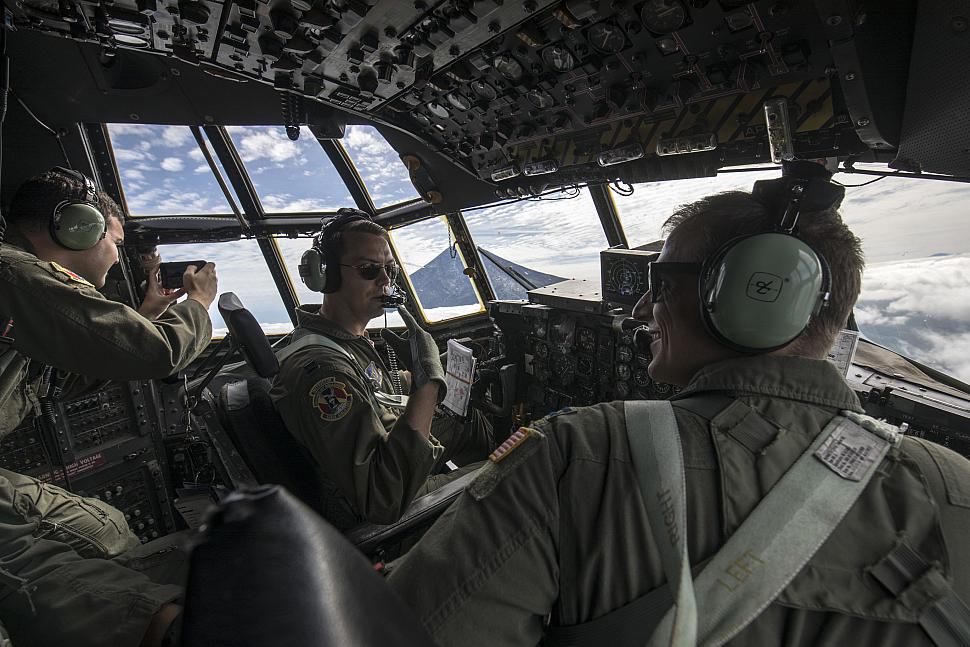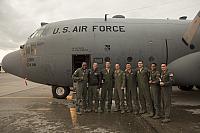C-130 News
C-130 Hercules News
The last tactical training mission
October 13, 2017 (by
Yasuo Osakabe) -
"We might see Mount Fuji today," said Capt. Travis Wilkes, 36th Airlift Squadron C-130H pilot and mission commander, during a mission briefing in the squadron conference room. It was a relaxing atmosphere around the table, much like any other daily mission briefing, but deep down everyone know this one was a little different.

It was different because this C-130H, assigned to the 36th AS, Oct. 5th, 2017, was flying its last tactical training sortie at Yokota Air Base, Japan. The aircraft soared over the Izu Peninsula, where Mt. Fuji is located, as well as the Japanese Alps. The crewmembers also performed a Low-Cost, Low-Altitude airdrop at Yokota at the end of the mission.
"We focused on mountainous low level flying, staying about 500 feet above the ground, and performed an LCLA airdrop," said Wilkes.
Last LCLA airdrop
The C-130H flew back to Yokota a little earlier than scheduled. Weather conditions around the drop zone were perfect - low wind and clear visibility. Crews kept communicating with each other to ensure precise timing of the airdrop. A loadmaster counted down. Soon, the back ramp opened. A loadmaster was in place, ready to cut a rope to drop the bundle – the last bundle to fall from a Yokota C-130H.
"[I felt] the same thing I feel every time I fly and execute LCLA in a C-130H; absolute joy," said Capt. Andrew Kochman, 36th Airlift Squadron C-130H navigator. "I'll admit that this time had a bittersweet tinge, but I don't think anything can overcome the thrill of low-level flying to precision LCLA airdrop."
The LCLA airdrop by Hercules aircrews is designed to make deliveries more accurate and flexible for resupplying mobile forces around the world. The crew constantly polishes their airdrop skills over Yokota.
"It is a lot of fun and challenging work," said Wilkes. "It is a big crew concept working with navigator, flight engineer and loadmasters to make sure the aircraft is flying safe to execute the LCLA airdrop mission."
One of the busiest LCLA training opportunities every year is Operation Christmas Drop, which offers a very unique experience for 36 AS crewmembers.
"OCD is without a doubt my most favorite experience in the "H" models. This is a training mission in which the 36th AS delivers tens of thousands of pounds of supplies to nearly 40,000 people across the Micronesian islands, an area that spans roughly the same distance as it is from coast-to-coast of the continental United States," said Wilkes.
The end of era
A blazing red in the sky at dusk and almost full moon appeared early over the flightline; a small crowd from the 36th AS waited, hiding their farewell champagne and listening to the sound of the "H" model turboprops as the aircraft taxied in after completing its final mission at Yokota.
"It was like reliving history," said Capt. Thomas Bernard, 36th Airlift Squadron C-130H pilot. "This aircraft has been a huge part of the USAF's missions across the world. I feel lucky to have been a part of that history."
As part of a military tradition with aviators, the crews stepped off the C-130H, tail number 74-2065, onto the tarmac where families, friends and co-workers waited to congratulate them. Suddenly, the tradition kicked off when everyone doused the crew with a bucket of ice water in celebration of completing the last "H" model operation, closing out an important chapter in Yokota's history.
The last C-130 "E" model left Yokota on September 17, 2007, giving way to the "H" models that have provided airlift capabilities for the region for more than a decade. During that time the C-130H conducted special operations, aeromedical evacuations, search and rescue operations, humanitarian relief and theater airlift mission in support of U.S. and U.N. security interests throughout the Indo-Asia Pacific region and around the world:
"It is sad to see the "H" models go and it was a privilege to be a part of the last active duty C-130H squadron," said Wilkes. "The transitions are necessary. The "H" tails we flew at Yokota were built 1974. The 374th Aircraft Maintenance Squadron worked hard to keep them airborne but they are old and would break from time-to-time. So while the "J" models have more cargo space, are able to fly higher and fly faster, perhaps the component that will help Yokota continue its mission as a key airlift hub in the Indo-Asia Pacific region is the C-130J's improved maintenance record. Aircraft reliability is a key component to the successful movement of cargo and personnel and the "J" models provide that."
"Plus, it has a flushable toilet!" added Wilkes.

Crew members with the 36th AS communicate during a training mission near Mount. Fuji, Japan, on October 5, 2017. This is the last active duty C-130H Hercules tactical training sortie. [USAF photo by Yasuo Osakabe]
"We focused on mountainous low level flying, staying about 500 feet above the ground, and performed an LCLA airdrop," said Wilkes.
Last LCLA airdrop
The C-130H flew back to Yokota a little earlier than scheduled. Weather conditions around the drop zone were perfect - low wind and clear visibility. Crews kept communicating with each other to ensure precise timing of the airdrop. A loadmaster counted down. Soon, the back ramp opened. A loadmaster was in place, ready to cut a rope to drop the bundle – the last bundle to fall from a Yokota C-130H.
"[I felt] the same thing I feel every time I fly and execute LCLA in a C-130H; absolute joy," said Capt. Andrew Kochman, 36th Airlift Squadron C-130H navigator. "I'll admit that this time had a bittersweet tinge, but I don't think anything can overcome the thrill of low-level flying to precision LCLA airdrop."
The LCLA airdrop by Hercules aircrews is designed to make deliveries more accurate and flexible for resupplying mobile forces around the world. The crew constantly polishes their airdrop skills over Yokota.
"It is a lot of fun and challenging work," said Wilkes. "It is a big crew concept working with navigator, flight engineer and loadmasters to make sure the aircraft is flying safe to execute the LCLA airdrop mission."
One of the busiest LCLA training opportunities every year is Operation Christmas Drop, which offers a very unique experience for 36 AS crewmembers.
"OCD is without a doubt my most favorite experience in the "H" models. This is a training mission in which the 36th AS delivers tens of thousands of pounds of supplies to nearly 40,000 people across the Micronesian islands, an area that spans roughly the same distance as it is from coast-to-coast of the continental United States," said Wilkes.
The end of era
A blazing red in the sky at dusk and almost full moon appeared early over the flightline; a small crowd from the 36th AS waited, hiding their farewell champagne and listening to the sound of the "H" model turboprops as the aircraft taxied in after completing its final mission at Yokota.
"It was like reliving history," said Capt. Thomas Bernard, 36th Airlift Squadron C-130H pilot. "This aircraft has been a huge part of the USAF's missions across the world. I feel lucky to have been a part of that history."
As part of a military tradition with aviators, the crews stepped off the C-130H, tail number 74-2065, onto the tarmac where families, friends and co-workers waited to congratulate them. Suddenly, the tradition kicked off when everyone doused the crew with a bucket of ice water in celebration of completing the last "H" model operation, closing out an important chapter in Yokota's history.
The last C-130 "E" model left Yokota on September 17, 2007, giving way to the "H" models that have provided airlift capabilities for the region for more than a decade. During that time the C-130H conducted special operations, aeromedical evacuations, search and rescue operations, humanitarian relief and theater airlift mission in support of U.S. and U.N. security interests throughout the Indo-Asia Pacific region and around the world:
- • Operation Enduring Freedom in the Philippines from 2002 to 2015
- • Operation Iraqi Freedom from 2004 to 2010
- • Operation Caring Response in Myanmar following tropical cyclone Nargis in 2008
- • Operation New Dawn from 2010 to 2013
- • Operation Tomodachi in 2011
- • Operation Damayan in the Philippines following Typhoon Haiyan in 2013
- • Operation Sahayogi Haat following the 2015 Nepal earthquake
- • Kumamoto earthquake relief effort in Japan, 2016
"It is sad to see the "H" models go and it was a privilege to be a part of the last active duty C-130H squadron," said Wilkes. "The transitions are necessary. The "H" tails we flew at Yokota were built 1974. The 374th Aircraft Maintenance Squadron worked hard to keep them airborne but they are old and would break from time-to-time. So while the "J" models have more cargo space, are able to fly higher and fly faster, perhaps the component that will help Yokota continue its mission as a key airlift hub in the Indo-Asia Pacific region is the C-130J's improved maintenance record. Aircraft reliability is a key component to the successful movement of cargo and personnel and the "J" models provide that."
"Plus, it has a flushable toilet!" added Wilkes.
Courtesy of 374th Airlift Wing/Public Affairs
Related articles:
Forum discussion:
Tags
- Yokota C-130J completes first training sortie (2017-03-22)
- Yokota welcomes PACAF’s first C-130J Super Hercules (2017-03-06)
- Wrapping up Operation Christmas Drop 2016 (2016-12-14)
- Yokota aids GoJ with earthquake relief (2016-04-18)
- Nepal relief airlift expands with deployment of Yokota aircraft (2015-05-06)
- C-130 Fighting Falcon news archive
Forum discussion:
- Start a discussion about this article in the C-130.net forum.
Tags

